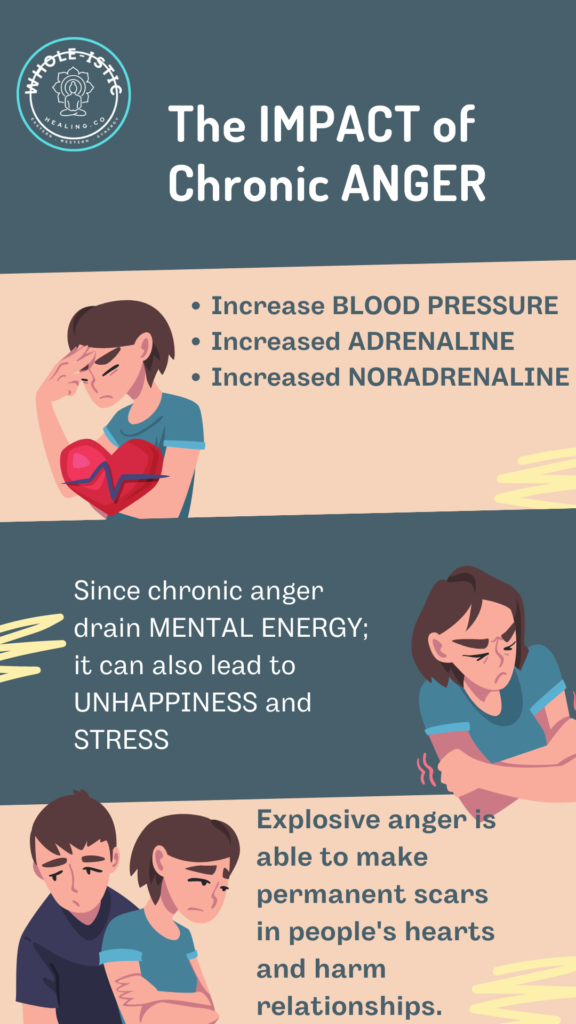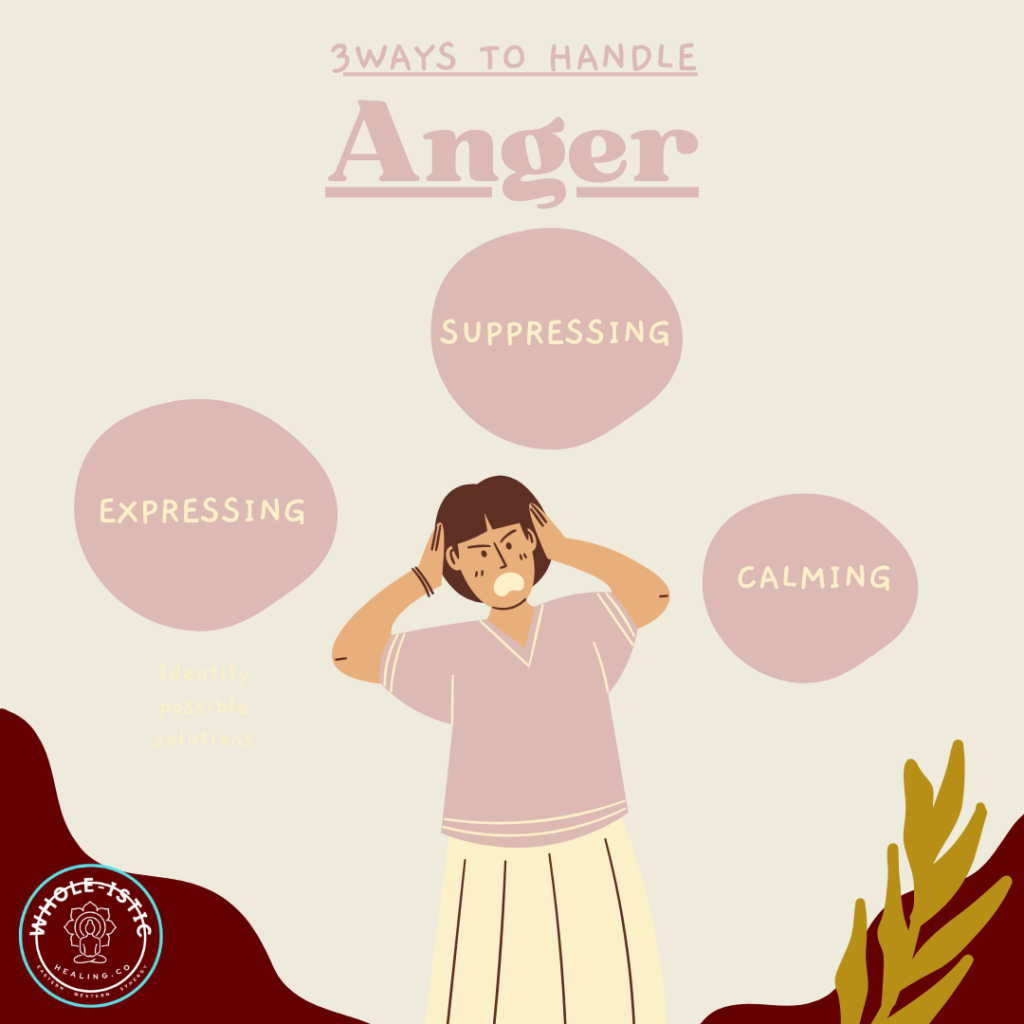anger
WHAT IS ANGER?
According to Charles Speilberger, PhD psychologist, anger is ‘an emotional state that varies in intensity from mild irritation to intense fury and rage’. It exerts physiological and biological changes when you get angry;
+ your heart rate and blood pressure go up
+ energy hormone levels increase; adrenaline, and noradrenaline.
Anger can be from external or exogenous sources; think traffic or a towards a person.
It can also be from an internal or endogenous source; think of festering over personal concerns or rehashing a trauma or event.
We have a magnet that says
‘For every minute that you are angry, you have lost 60 seconds of happiness’, which when put like that is hard to deny!
However, as a working Mum, with extracurricular activities coming out of our eyeballs, I will admit that anger is something that I am always grappling with!
The time pressure, noise, mess, kids not listening, constantly cleaning up after them, helping with homework, making sure they have what they need for every day, keeping on top of business admin, home admin…sometimes it feels like a ‘PRESSURE COOKER’ situation.
Add in the full-moon and PMS, which just so happen to align, then it is a recipe for having low patience and the ability to snap seemingly quickly…though it is the accumulation of all of those sensory overload that has lead me to that point.
As an adult, I know that I need to be a role model. The ‘do as I say, and not as I do’, is becoming harder to model. It requires a constant checking-in and trying to do better each day, because I can’t get upset at my boys for reacting in an angry or abrupt way, if that is how I respond!
Whilst I am not making excuses, but I can see how as working parents, living in the modern world that we do, that we are pushing ourselves more and more to strive and give our kids their best life. This can however show up in shorter patience thresholds.
ARE SOME PEOPLE MORE PRONE THAN OTHERS TO ANGER?
According to APA.ORG, some psychologists believe that people who are easily angered may have a ‘low tolerance for frustration’. This can be genetic or physiological, as well as being sociocultural (where it is not accepted to show anger, so do not learn how to channel it constructively). Interesting article here; https://www.apa.org/topics/anger/control
From an Ayurvedic perspective, people with a PITTA PRAKRUTI or natural constitution or a PITTA VIKRUTI (imbalance), there is the FIRE and WATER elements at play. With more heat qualities, these people tend to exhibit more anger reactions than someone with a KAPHA PRAKRUTI or VIKRUTI.
This enables understanding that on a hot day, if eating more heating VIRYA (energy) foods/spices & partaking in heating practices, that the FIRE quality will enhance. We would encourage more cooling qualities in diet and lifestyle to help bring balance and to reduce this excess fire.
I would also look into childhood and how anger was seen within the home; pushed under the rug, not expressed in a healthy way or not even allowed to show anger?
There can be learned behaviours that until NEW skills are learned to better handle emotions and reactions, that we are unable to grow and evolve.
WHAT ARE WAYS TO HANDLE ANGER?
- EXPRESSING
In an assertive way by explaining what your needs are is a healthy way to handle anger. It is no longer healthy if it is expressed in an AGGRESSIVE way.
- SUPPRESSING
This is when you hold it in, which can become deleterious to our body as it can cause high blood pressure or depression by letting it fester and not be expressed. It also can come out in other ways of being cynical and snide comments, by ignoring the underlying issue.
It can also be redirected and channelled into something more positive; which is great in the ‘ACUTE’ situation rather than reacting immediately. I would always though encourage to come back into expressing the NEEDS behind the anger to stop it festering/BUBBLING underneath the surface!
- CALMING
Using strategies to calm internal reactions, as well as external responses. The physiological responses of CNS arousal; increased heart rate, blood pressure, stress hormones can reduce and this is great for an ACUTE situation…and then handle the underlying reason!
What I would ask then, is to look into a few ponderings?
+ What makes you tick?
+ What factors contribute to this final blow up?
+ Is there a cyclical pattern to this anger?
+ What helps you get through it?
+ How often is it happening? Is it happening more frequently? *
+ Is it affecting your relationships at home or work? *
These can help unveil exactly WHEN and WHY it is happening, which is SO important!
The * indicates that it is a great idea to seek help and look into this more before it creates more impact in your life.
WHAT STRATEGIES CAN I USE WHEN I FEEL ANGRY?
This can be at home, in the car or at work! Whilst anger is a natural outlet for our feelings, it is not a sustainable reaction to maintain healthy relationships and a healthy work environment.
We need strategies!
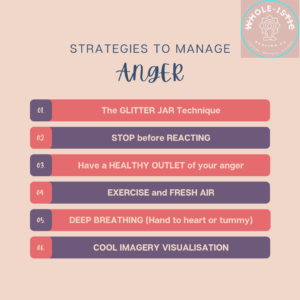
- THE GLITTER JAR CONTAINER
Imagine a shaking a glitter jar and it is going everywhere. Then stay still…and imagine all the glitter settling to the bottom; becoming slow and calm. Great visualising technique!
- STOP BEFORE REACTING/SPEAKING
In the moment of yelling or responding…STOP.
Breathe.
Walk away if you have to.
Then respond, not immediately and not fuelled by the immediate ANGER FIRE response.
- HAVE A HEALTHY OUTLET FOR YOUR ANGER IN THAT ACUTE MOMENT
Squeeze a stress ball. Scream into a pillow if you are alone and able.
Ari has a towel on his golf bag that he can squeeze when he feels frustrated at golf.
Shake off your clenched fist…Unclench your jaw if it is tightened. Shoulders back and relaxed.
All releasing the stored anger…not letting it fester within; but not expressing it in a sudden, aggressive or explosive way!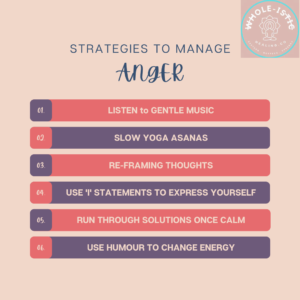
- GET SOME EXERCISE/ FRESH AIR
Literally in the heat of the moment, go for a brisk walk or run in the fresh air. It is a healthy outlet of internal energy, allows you to clear your mind, and exert that bubbling energy.
Ari walks along the cart if he is frustrated, to let it out from his body.
Getting an outlet and upsurge of endorphins to help settle our stress hormones.
- DEEP BREATHING (HAND TO HEART OR ON TUMMY)
Close your eyes, put your hand on your heart or tummy…and take 10 DEEP DIAPHRAGMATIC breaths (my solution to everything!)
In through your nose…and out through your mouth.
You can do this with your eyes open too if you feel embarrassed or are out or driving.
This will SLOW down your SYMPATHETIC NERVOUS SYSTEM, and activate more relaxation and SLOW breathing.
- REPEATING A MANTRA/CALMING WORD
Your attention and MIND is going to focus on this MANTRA ‘OM’ or relaxing word ‘RELAX’…’YOU’VE GOT THIS’…
Say it out loud or in your mind…and just keep your focus here; bringing your mind back every time.
- IMAGERY VISUALISATION
Imagine yourself sitting at the OCEAN…or in the SNOW…on top of a MOUNTAIN.
Visualisation is powerful, and our body doesn’t know if it is real or not!
Ideally picture COOLING places, as intuitively it makes sense to imagine yourself with water or ice, to naturally COOL down. This is ALL to get you into a CALMED state, after which you can express your feelings and concerns in a CALM and centred manner.
- PUT ON SOME MUSIC
Whatever music you like; it can CHANGE the energy! I love FLUTE and SPA music to keep me calm…it connects my SOUL to my body and mind, and I often have it whilst I am driving (with my seat warmers that make me feel like I am getting a hug!)
IT definitely can change the energy!
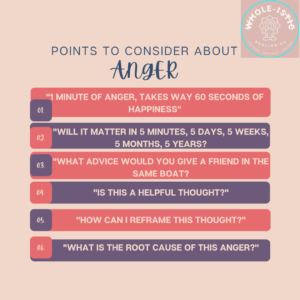
9. SLOW YOGA ASANAS
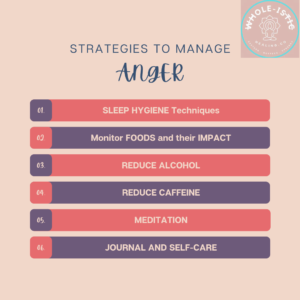
Allows the BODY and MIND connection to FLOW together. It allows the BREATH to come back into your BODY; whilst moving the energy throughout your limbs.
Flow is the opposite of tension and constriction; so it allows the FIRE energy to extinguished and flow out of your body in a healthy and PRANA-RICH way.
10. RE-FRAMING THOUGHTS (can often be a reaction to fear, or focusing on catastrophic thinking and replace with more GREEN TEAM thoughts and rational thoughts)
Looking into your MINDSET, as certain thought processes can feel very catastrophic in the moment;
-ALL or NOTHING mindset
-CONTROL
-COMPARISON
-CATASTROPHIC thinking (Phrases like NEVER, ALWAYS)
Ask yourself
‘Will it matter in 5 minutes, 5 days, 5 weeks or 5 years’ time?’
If the answer is no, then let it go! Don’t sweat the small stuff!
11. CHECK IF YOU’RE HUNGRY!
This is the FIRST thing we do in this household! We ALL get HANGRY!
99.9% of the time, once we have been fed, we are better able to regulate our emotions and have a healthier expression of our concerns and feelings! The dip in sugar levels can contribute to how you are feeling; simple yes, but a relevant one!
12. ONCE CALM EXPRESS YOURSELF USING ‘I’ STATEMENTS VS BLAME OR CRITICISM
Now that you are calm, express your feelings and concerns from an ‘I’ perspective. ‘I feel frustrated that there is mess that I have to clean’…vs ‘You always leave mess everywhere’.
This is taking power of how you are feeling, you are not passing blame, but allowing a healthy discussion to go to step 13
13. RUN THROUGH SOLUTIONS
Once you have been heard (I don’t like going into solution mode until I feel like my voice has been heard and feelings have been acknowledged and validated!), then as a collective of who is involved, run through possible solutions!
It requires understanding WHAT your triggers are, and WHER things can be adjusted to meet YOUR needs
14. USE HUMOUR TO CHANGE THE ENERGY
Having a laugh can change the energy, and we often giggle if we’ve had an anger outburst and just chuckle about it!
Holding onto grudges and your point of view, only keeps you festering and bubbling for longer…so have a giggle, lighten the mood and then go into solution mode!
15. TIMING; DON’T BRING UP BIG ISSUES WHEN TIRED OR LATE AT NIGHT, OR WHILST KIDS ARE SCREAMING
Timing is everything! Don’t bring up stressful topics of money, mess, children’s behaviour etc. if you are tired, it’s late, the kids are screaming or fighting…it is a recipe for disaster!
Pick the best time that feels spacious to hash things out in a calm and cool way.
16. ENSURE YOU ARE SLEEPING WELL
Sleep is a crucial pillar of health and wellbeing! Lean into SLEEP HYGIENE practices (a blog and podcast about this), as good quality sleep will ensure that you are better equipped to handle what happens through the day and better able to manage triggers to your ANGER.
17. IMPACT OF FOODS FROM AN AYURVEDIC PERSPECTIVE
The energy or VIRYA of food have an impact on our body. Foods that are HEATING and adding the FIRE quality, can increase the anger and FIRE within us. For example, chilli, cayenne pepper, garam masala; they are heating vs cucumber, coriander and fennel are cooling to the system.
Foods can also impact the GUNAS of the mind, so food that is RAJASIC, increase the agitation can enhance anger outbursts also. For example; garlic and onion, as well as caffeine and alcohol are considered RAJASIC and can enhance the agitation of the mind.
18. IMPACT OF ALCOHOL AND CAFFEINE
As mentioned above they can impact the GUNAS of the mind from an Ayurvedic perspective, Also, caffeine being a stimulant is up-regulating our CNS responses and heightening our arousal and reactions.
Alcohol can impact the biochemistry in our brain, and with reduced inhibitions, it can lead to an increase in violence. Therefore, it is important to note the impact of alcohol on our system.
19. MEDITATION
This is a MINDFULNESS tool that can help our mind to be more SATWIC, more calm and composed and better able to respond in a calm manner when we practice it regularly.
It can be whilst doing daily activities, as well as a dedicated practice, but can impact our entire system to feel more calm and serene.
20. WATERFALL SHOWER
An energetic practice that I have written a waterfall meditation in my book ‘Shining The Light on PND’. As you are showing, you are imagining a white cleansing light washing over your body and cleansing it energetically. Requires visualisation and focus; but very helpful!
21. MANDALA COLOURING IN
MINDFULNESS practice that can steady the mind and allow it to be more calm and SLOW.
22. JOURNAL YOUR ANGER AS AN OUTLET
I love this tool; allows you to hash out your emotions in a healthy way and reflection allows you to get to the bottom of the ROOT causes!
23. SELF-CARE; Anger can be a sign that your ‘cup’ is not full, or your needs are not being met
Perhaps anger is the result, but not looking after your own needs is the underlying ‘CRY OUT’ that your body and mind are saying.
Partaking in self-care strategies to keep you nourished and rejuvenated is important. It helps to keep our VATA system regulated by bringing EARTH qualities which is grounding and allows our nervous system to be supported.
It is not a luxury, and you are so deserving to have your needs met!
I love this link; https://positivepsychology.com/anger-management-techniques/
To Challenge your thoughts
Therapists often begin by focusing on a client’s negative thoughts or cognitive distortions (Dyer, 2020).
Consider:
What advice would you give to a friend?
What supporting evidence do you have?
Is this a helpful thought?
What will you think in a week/month/year?
WHEN TO SEEK HELP?
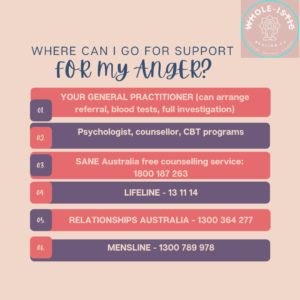
If ANGER is affecting your relationships, your quality of life or becoming more frequent then it is definitely worth investigating it further.
- See your GP to discuss it all, they can then refer you to exactly where you need to go
- Psychologist or counsellor; CBT, conflict resolution, couples counselling (whatever it is that YOU need!)
- Support group or online support groups
It is also important to note that every reaction is telling us something;
+ it could be an underlying health condition; anxiety or depression
+ requirement for looking into stress management techniques
+ work/life balance reflection
+ Diet and lifestyle investigation
SUPPORT LINKS:
- MensLine Australia — Anger Management Toolkit
- Headspace — What is anger
- SANE Australia — free counselling service — 1800 187 263
- Australian Psychological Society — Anger
- Lifeline — 13 11 14
- Kids Helpline — 1800 55 1800
- MensLine — 1300 78 99 78

